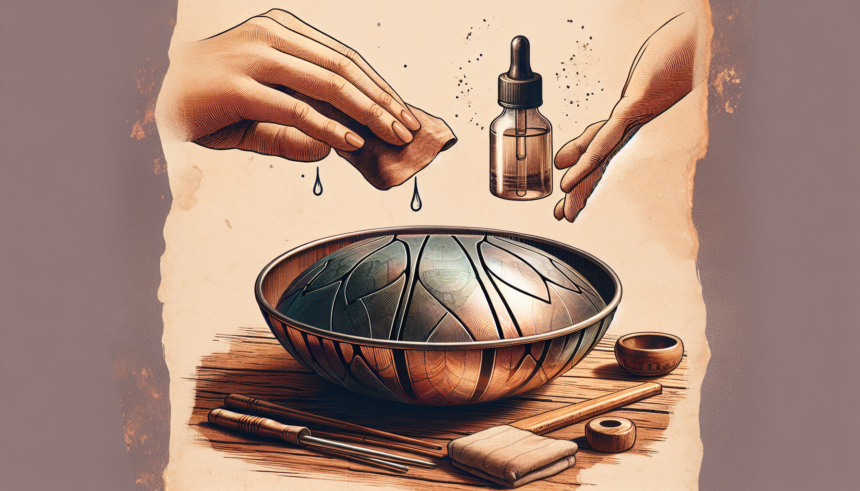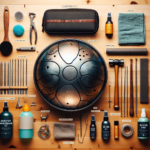Handpan Maintenance 101: Importance of Regular Oiling
A handpan is a beautiful and unique musical instrument that produces ethereal and serene sounds. If you are a proud owner of one, you already know how special it is. However, to maintain its beauty and functionality, regular maintenance is mandatory. One of the most significant aspects of handpan maintenance is regular oiling. This process, although often overlooked, plays an essential role in maintaining the instrument’s longevity and sound quality.
Why Regular Oiling is Essential
Regular oiling is critical for several reasons:
- Prevents Rust: Handpans are typically made of nitrided steel or stainless steel. Despite their durability, these metals are still susceptible to rust, especially in humid conditions or when exposed to moisture. Oiling acts as a protective barrier against rust and oxidation.
- Maintains Sound Quality: Rust and corrosion can adversely affect the instrument’s sound quality, causing it to sound dull or distorted. Regular oiling ensures that the handpan remains in optimal condition, preserving its pristine sound quality.
- Extends Lifespan: Proper maintenance, including regular oiling, extends the life of your handpan. By preventing rust and other forms of damage, you can enjoy your instrument for many years.
- Enhances Aesthetic Appeal: A well-maintained handpan looks beautiful. Regular oiling keeps the surface shiny and free from blemishes, ensuring that it remains visually appealing.
How to Oil Your Handpan
Oiling your handpan isn’t a complicated process. Here are the steps to follow:
- Choose an Appropriate Oil: You can use various oils for this purpose, such as pure lemon oil, coconut oil, or handpan-specific oils available in the market. Ensure that the oil you choose is free from additives and chemicals.
- Clean the Surface: Before applying the oil, make sure the surface of the handpan is clean and dry. You can use a soft cloth to wipe off any dust or fingerprints. If needed, use a mild, non-abrasive cleaner.
- Apply the Oil: Pour a small amount of oil onto a soft, lint-free cloth. Gently rub the oil into the surface of the handpan, covering all areas evenly. Ensure that you don’t apply too much oil; a thin layer is sufficient.
- Buff the Surface: After applying the oil, use a dry part of the cloth to buff the surface. This helps to remove any excess oil and gives the handpan a shiny finish.
- Let it Dry: Allow the handpan to sit for a few hours to let the oil fully penetrate and dry. This ensures better protection and a long-lasting effect.
Frequency of Oiling
How often you should oil your handpan depends on several factors, including your local climate, how often you play the instrument, and how frequently it is exposed to elements like moisture and sweat. Generally, it is advisable to oil your handpan once a month if it’s played frequently. However, if you live in a very humid area, you might need to oil it more often. Conversely, in dry climates, you could extend the interval between oiling sessions.
Additional Maintenance Tips
Besides regular oiling, there are other maintenance practices that can help maintain the quality and lifespan of your handpan:
- Proper Storage: Always store your handpan in a cool, dry place. If you’re not using it for an extended period, consider using a dehumidifier or silica gel packs to absorb moisture.
- Avoid Extreme Temperatures: Extreme heat or cold can damage the metal and affect the tuning. Keep your handpan away from direct sunlight or heaters.
- Handle with Care: Avoid dropping or hitting your handpan on hard surfaces. Always handle it with care to prevent dents and scratches.
- Use a Protective Case: When transporting your handpan, use a protective case to prevent any physical damage.
- Regular Inspections: Regularly inspect your handpan for any signs of rust or damage. Early detection can prevent further deterioration.
Conclusion
Regular oiling is a crucial aspect of handpan maintenance that should not be overlooked. It prevents rust, maintains sound quality, extends the lifespan of the instrument, and keeps it looking beautiful. By incorporating regular oiling into your maintenance routine, you can ensure that your handpan remains in optimal condition, providing you with beautiful music for years to come. Remember to choose the appropriate oil, apply it correctly, and consider other maintenance tips to keep your handpan in top shape. Investing a little time and effort into caring for your handpan will pay off in the long run, allowing you to enjoy this unique instrument to its fullest potential.
FAQs
Q1: What type of oil is best for handpan maintenance?
A1: Several types of oil can be used for handpan maintenance, including pure lemon oil, coconut oil, and handpan-specific oils. Ensure the oil you choose is free from additives and chemicals for the best results.
Q2: How often should I oil my handpan?
A2: The frequency of oiling depends on your local climate, how often you play the instrument, and its exposure to elements like moisture and sweat. Generally, oiling once a month is advisable, but this may vary based on your specific conditions.
Q3: Can I use any cloth to oil my handpan?
A3: It is best to use a soft, lint-free cloth for oiling your handpan. This ensures that you do not scratch the surface and that the oil is applied evenly.
Q4: What should I do if my handpan already has rust spots?
A4: If you notice rust spots on your handpan, it’s essential to address them immediately. You can use fine steel wool to gently remove the rust, followed by thorough oiling to prevent further oxidation.
Q5: Can regular oiling alter the sound of my handpan?
A5: Regular oiling helps maintain the sound quality of your handpan. Without it, rust and corrosion can negatively impact the instrument’s sound. Proper oiling should not alter the sound but preserve its original quality.





